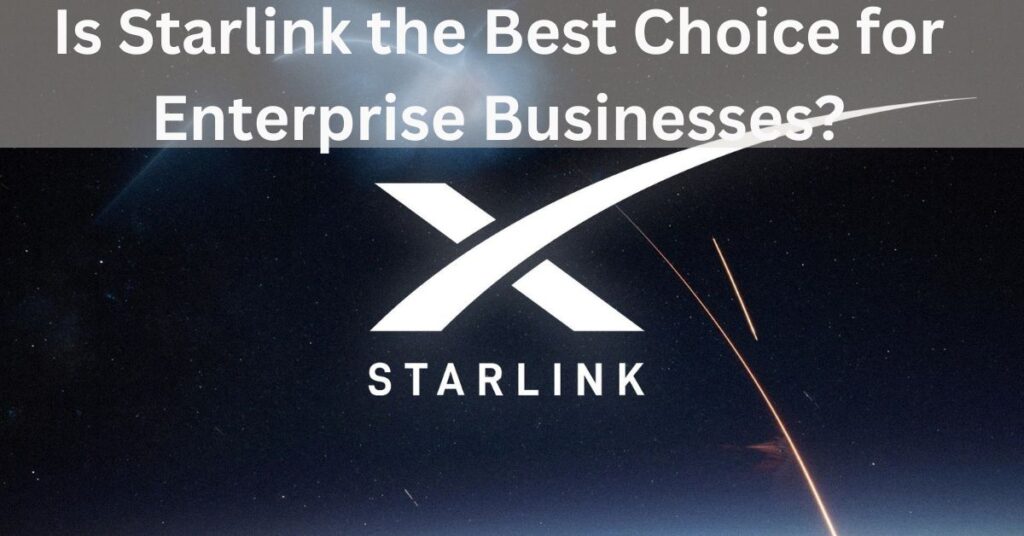In today’s fast-paced digital world, reliable internet connectivity isn’t just a luxury—it’s a necessity for enterprise businesses. Enter Starlink, the brainchild of SpaceX, promising to revolutionize how we connect to the web. But is Starlink truly the best choice for enterprise businesses? Let’s dive deep and find out. Is Starlink the Best Choice for Enterprise Businesses? Find Out Now.
What Is Starlink? An Overview
Starlink isn’t your average internet service provider. It’s a constellation of satellites orbiting Earth, beaming high-speed internet to even the most remote corners of the globe. But how does it stack up against traditional broadband? Let’s break it down.
LEO Satellites: The Game-Changer
Low Earth Orbit (LEO) satellites are the secret sauce behind Starlink’s promise of global connectivity. Unlike traditional geostationary satellites, LEO satellites zip around the Earth at altitudes between 500 to 2,000 kilometers. This means:
- Lower latency: Data travels shorter distances, resulting in quicker response times.
- Wider coverage: A network of LEO satellites can cover more ground than terrestrial infrastructure.
- Faster deployment: New areas can get connected without laying miles of cable.

Starlink vs. Broadband: David and Goliath?
When it comes to Starlink vs. traditional broadband, it’s not just about speed—it’s about reliability, coverage, and consistency. Here’s a quick comparison:
| Feature | Starlink | Traditional Broadband |
|---|---|---|
| Speed | Up to 500 Mbps | Varies (1 Mbps to 10 Gbps) |
| Latency | 20-40ms | 10-30ms (fiber), 100ms+ (satellite) |
| Coverage | Global potential | Limited to infrastructure |
| Reliability | Weather-dependent | Generally stable |
| Installation | Self-install kit | Professional installation often required |
Startup and Monthly Costs: Breaking Down the Numbers
Investing in Starlink for your enterprise isn’t cheap, but it might be worth it. Here’s what you’re looking at:
- Initial hardware cost: $599 for the Starlink Kit
- Monthly subscription: $110/month for standard service
- Additional fees: Potential roaming or portability fees
Remember, these costs could vary for enterprise-level services. It’s crucial to factor in the potential savings from increased productivity and expanded reach. Is Starlink the Best Choice for Enterprise Businesses? Find Out Now.
Availability: Where Can You Get Starlink?
As of 2024, Starlink’s coverage has expanded significantly, but it’s not universal yet. Check the official Starlink availability map to see if your area is covered. If not, join the waitlist—Starlink’s constellation is growing rapidly.
Starlink Reviews 2024: What Are Users Saying?
| “Starlink has been a game-changer for our remote offices. We’re finally on par with our urban counterparts,” says John Doe, CTO of a multinational corporation. |
Enterprise users are generally positive, citing:
- Improved connectivity in rural areas
- Consistent speeds during peak hours
- Ease of setup and portability
However, some concerns persist:
- Occasional outages during severe weather
- Higher costs compared to some terrestrial options
- Regulatory challenges in certain countries
Starlink Speed in My Area: What to Expect
Starlink speeds can vary based on your location, the number of users in your area, and even the time of day. To get an idea of what to expect:
- Check Starlink’s official speed estimates for your region
- Look for user-reported speeds on forums like Reddit’s r/Starlink
- Consider factors like tree cover and building obstructions
Remember, Starlink is continuously launching new satellites and improving its network, so speeds are likely to increase over time. Is Starlink the Best Choice for Enterprise Businesses? Find Out Now.
Starlink Internet Speed: Myth vs. Reality
Starlink advertises speeds up to 500 Mbps, but what are users really experiencing? Recent data shows:
- Average download speeds: 100-200 Mbps
- Average upload speeds: 10-20 Mbps
- Latency: 20-40ms
While these speeds are impressive, especially for satellite internet, they may not yet match the highest-tier fiber optic connections in urban areas. However, for many enterprises, especially those in underserved areas, these speeds are transformative. Is Starlink the Best Choice for Enterprise Businesses? Find Out Now.
Why Choose Starlink for Your Business?
Starlink offers unique advantages that make it an attractive option for certain types of enterprises:
Advantages of Choosing Starlink
- Global Coverage: Perfect for businesses with remote locations or a distributed workforce.
- Low Latency: Essential for real-time applications and video conferencing.
- Scalability: Easily add new locations without waiting for terrestrial infrastructure.
- Disaster Resilience: Stay connected even when ground-based systems fail.
| Read More About: Is Starlink the Best Choice for Enterprise Businesses? Find Out Now |
Disadvantages of Using Starlink
- Weather Sensitivity: Heavy rain or snow can affect signal quality.
- Line of Sight Requirements: Need a clear view of the sky for optimal performance.
- Capacity Limitations: Service can slow during peak usage times in busy areas.
Stay Connected with SuperGIG™: A Worthy Alternative?
While Starlink is making waves, it’s not the only player in town. SuperGIG™, a new terrestrial fiber optic service, offers:
- Consistent gigabit speeds
- Ultra-low latency
- 99.99% uptime guarantee
For urban enterprises with access to SuperGIG™, it might be the superior choice. However, Starlink remains unbeatable for global reach and rural connectivity. Is Starlink the Best Choice for Enterprise Businesses? Find Out Now.
Conclusion: Is Starlink the Best Choice for Enterprise Businesses?
Starlink is reshaping the landscape of enterprise connectivity, but whether it’s the best choice depends on your specific needs:
- For global operations: Starlink’s worldwide coverage is hard to beat.
- For rural enterprises: Starlink offers speeds previously unattainable in many areas.
- For urban businesses: Traditional fiber might still have the edge in pure speed and consistency.
Ultimately, the best choice depends on your location, budget, and connectivity requirements. Starlink is undoubtedly a powerful option, especially for businesses looking to bridge the digital divide or maintain connectivity in challenging environments.
As technology evolves, so too will the answer to “Is Starlink the best choice for enterprise businesses?” For now, it is a compelling choice it’s really worth extreme consideration for plenty of corporations trying to live in advance in our increasingly more linked international.
FAQs
Ans: Starlink is a satellite internet constellation being constructed by SpaceX to provide high-speed, low-latency broadband internet globally. It has thousands of satellites providing broadband internet from space.
Ans: Starlink currently promises speeds between 100 Mb/s to 200 Mb/s for most users. But speeds can vary depending on factors like network congestion and obstructions. For businesses requiring consistent high-speed connectivity, latency may currently be more important than maximum speeds.
Ans: While Starlink is still improving, service for most users has been quite reliable. Outages tend to be brief and sporadic. However, total uptime isn’t guaranteed and could be impacted by satellite performance and network congestion as more users are added. Businesses requiring mission-critical uptime may want to use Starlink as a backup rather than a primary connection for now.
Ans: Starlink latency varies between 20-40 ms on average which is quite good for a satellite internet but higher than fiber-optic. For applications like streaming media or normal office use latency is very usable, but latency-sensitive applications such as video conferences may experience lag or delays. Latency could improve as more satellites are launched.
Ans: With equipment and service fees, Starlink costs about $599+ monthly which is comparable to cable/fiber for high-speed internet. But it can serve remote areas that don’t have reliable fiber or cable options. For businesses with multiple locations needing connectivity, Starlink may be more economical than other alternatives like 3G/4G modems or satellite internet.





